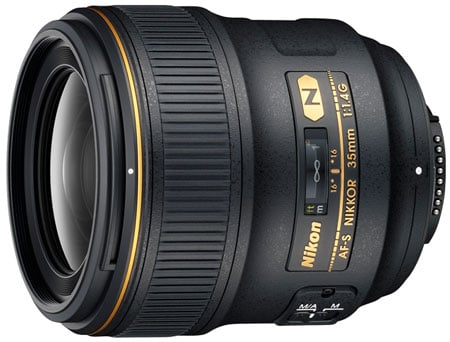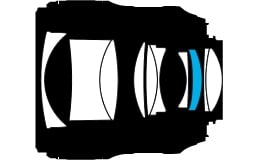Nikon 35mm f1.4G review
-
-
Written by Thomas
Intro
The Nikkor AF-S 35mm f/1.4G was announced September 2010 as the last prime to complete the updated series of 24mm, 50mm, and 85mm f/1.4 models in Nikon’s line-up.
Its focal length is one of the most useful on both DX and FX format bodies. On the former it delivers close to standard 50mm coverage for general-purpose work, while on the latter it offers mild wide-angle, squeezing in more than a standard lens while avoiding the obvious distortion of shorter focal lengths.
In this review we’ll have a look at Nikon’s most expensive current 35mm prime, and find out whether the lens lives up to the expectations.
 |
Facts from the catalog
Let’s have a look at the technical data and make some comparisons to similar lenses. We’ve rated the features with a [+] (or [++]), when it’s better than average or even state of the art, a [0] if it’s standard or just average, and [-] if there’s a disadvantage.
Size: 83x90mm = medium size, but double the length of the 35/2.0 and 17mm longer than the Zeiss 35/2.0. This size is still pretty decent although it’s funny to see a wide-angle lens being so long. [0]
Weight: 600 g = the heaviest of all current 35mm lenses, 70g heavier than the Zeiss, almost 400g more than my diminutive 35/2.0D. [-]
Optics: 10 elements in 7 groups = one element more than the Zeiss and 4 elements/2 groups more than the 35/2.0. Still this is far better than the zooms that tend to have something like 15/11 for the Nikon 24-70/2.8 or 14/11 for the Nikon 14-24/2.8. That bodes well for contrast and flare-resistance – helped by that mysterious Nano-coating that Nikon is using like snake-oil to improve lens-performance. Looking at the cross-section you see the interesting design with one big/deep central lens-element plus one aspherical element (blue) – but no ED-glass. [+]
Closest focus distance/max. magnification: 0.3m / 1:5. This is almost up to the current 35/2.0 which goes to 1:4.2, the DX Nikkor 35/1.8 reaches only to 1:6.2. [+]
Filter-thread: 67mm = smaller than what most pro-lenses use. So filters are cheaper, but you cannot use your standard 77mm filters. [0]
IS: No = a pity. The Nikon 16-35/4.0 zoom has VRII. But with a 3 stops larger aperture you could easily crank up the shutter speed to where shake is less likely. Still: in low-light situations when you need large dof and/or don’t want to increase ISO any further you’ll miss VR. [-]
AF: AF-S with SWM (silent wave motor), so does work on D60/3000/5000-bodies. Manual-focus override by turning the focus ring. [+]
Covers full frame/FX or smaller = very good. Just like the Nikon AF 35/2.0D. The Nikon DX 35/1.8G does cover more than DX but still produces some serious corner shading on FX. [+]
Comes with a flexible lens pouch, not a nice soft-case. [0]
Price: around 1600 EUR new (incl. 19% VAT) = expensive. The 35/2.0 is around 300 EUR, the Zeiss (manual focus only!) at 800 EUR. But the new lens has a one stop wider aperture and autofocus, so it fits well into the overall pricing landscape. [-]
The lens-caps are standard Nikon’s. The others still play catch-up. [+]
Distance information is relayed to the camera, so the Nikon body can do all the advanced exposure-related stuff with this lens. But this is true for all the alternatives too. [+]
Aperture ring = no, just like all Nikon G-lenses. [0]
Lens-shade included and reversible for transport. [+]
Sealing: yes! The 35/2.0 has none. [+]
So the final score in the “features-department” is three negative, four average and eight positive (3[-] / 4[0] / 8[+]).
Motivation
:
Large aperture lenses are for isolating your subject. I need this as a nature shooter and even as a landscape shooter I love to have not everything in equal sharpness. So going for 35mm focal length – which is in my opinion the new “normal” on FX bodies – this new lens should prove very valuable for my kind of shooting, once the D700-successor arrives. On a DX-body it “behaves” like a 53mm lens, a “normal-lens” by traditional standards.
Alternatives
:
– The old Nikkor AF 35/2.0: A good lens but with weakness in the FX corners. Small, light and comparatively cheap. See my quick review here.
– The Nikkor AF-S 35/1.8 DX: great, cheap little lens for DX bodies. Reaches its limits on FX bodies regarding vignetting, and corner sharpness. See Gordon’s review there.
– The Zeiss Distagon T* 35/2.0 manual focus: Some people really love it, but it has no AF which is a no-no for me when I want to use the lens wide open.
– Sigma has only a 30/1.4 for DX bodies which is very good in the center but lacks sharpness in the corners even at f4.0.





